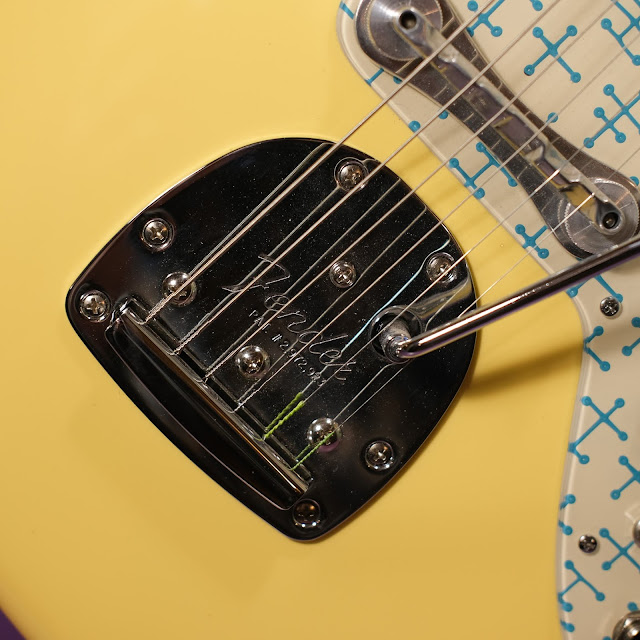2010/2019 Fender Partscaster Jazzmaster Electric Guitar
This lovely critter uses a Fender Mexico neck (2010 "vintage-style" Strat neck) and lightweight body (2019 Player body in buttercream) and a US-made TV Jones SuperTron pickup. Said pickup has a killer, full sound that's somewhere between that classic FilterTron rockabilly voice and the smoother, drivier growl of a Gibson bucker. I've got a series/parallel switch on board so one can almost get a clean "single-coil" sort-of sound in parallel mode, too.
This is, of course, something I "had" to make because a friend traded the neck to me towards work. I can't stand disembodied necks... so it had to be made!
This is, of course, something I "had" to make because a friend traded the neck to me towards work. I can't stand disembodied necks... so it had to be made!
The fancy parts come in a Decoboom-made custom pickguard (it's gorgeous) in a '50s-style "Eames Dots" pattern and a US-made Bigsby "Sorkin-style" aluminum bridge compensated for wound-G stringing. I had to knock the neck angle back a bit to use that bridge but I really wanted it so I could have a steep break angle on the bridge from the vibrato and the more "archtop-ish" feel and sound of its mounting-style.
My main complaint with Jazzmaster bridges is the tiny point of contact the adjusters of the bridge feet make in the "well-cups" of the normal design. It tends to yield a more steely/airy sound and I was trying to get a more jazzy, full-contact sound out of this guy -- and that is what it gets.
I also cut the whammy's arm down a bit shorter because the Player body moves the tailpiece/whammy unit forward and thus the bar hovered over the pickup when in regular use and I prefer my bars to be closer to the bridge so they're more out of the way and I can easily "sneak-in" and use it without having to push it aside much.
These changes add-up to an instrument that behaves with the comfort of a Jazzmaster in the lap but with more of the handling and sound of an earlier-era Gibson jazzbox with a Bigsby on it in the right hand. The vibrato effect is still very much the sound/vibe of a normal Jazzmaster unit and it stays in tune just as well, but it's a little more restrained with the different components.
Controls are simple -- one volume, one tone, and a series/parallel switch for the pickup. One can even use that as a lead/rhythm switch in a pinch. The pots are 500k and the tone knob is in "front" rather than the volume.
Work included: a fret level/dress and putting-together of all the components -- plus setup.
Setup: action is bang-on at hair-over 1/16" EA and 1/16" DGBE at the 12th fret, strung with 52w-11 gauges with a wound G string. The bridge is compensated for wound G and I simply prefer wound G myself, hence that choice. One can get plain-G-compensated tops for this style of Bigsby bridge, however, and the original "cups" for a Jazzmaster/Mustang-style bridge are under it in case one wanted to use a traditional bridge or move to plain-G stringing.
Scale length: 25 1/2"
Nut width: 1 11/16"
String spacing at nut: 1 7/16"
String spacing at bridge: 2 1/16"
Body length: 19"
Lower bout width: 13 5/8"
Waist width: 9 1/2"
Upper bout width: 11 1/8"
Side depth: 1 5/8"
Body wood: guessing basswood of some sort as it's light
Neck wood: maple
Fretboard: maple (one-piece w/neck)
Bridge: Bigsby USA "Sorkin"-style
Neck feel: '60s-style medium C with 9.5" board radius, slim-med frets
Condition notes: the neck shows minor usewear throughout but every other component is new and looks it save the body -- the first time I handed it to someone to try out, they put a tiny ding in the back near the tummy cut. That's pictured. The pickguard screws are stainless, too.
^^ above is the ding on the back.






















Comments